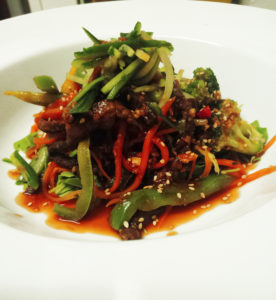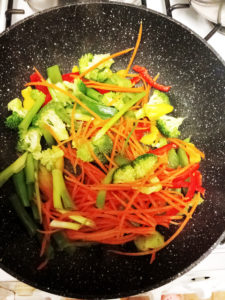Musings of a mature student
I have to budget (like all of us do!) as a student, so I have been looking at ways to eat well and save pounds….and lose pounds too! My food bill is around £25-£30 per week, although a lot of that is on things that take a long time to use up, like oil, salt, mayo… store cupboard essentials. Although there are many great (and heavily discounted) eateries around campus, and it’s great to eat out with friends, there is something satisfying about cooking and having friends round to dinner. Even better if you club together to buy the ingredients or have different hosts even once a week.
The important thing is to strike a balance – it would be great to have dedicated ‘eat out together’ nights and some eat-in dinner parties too and think what you could do with the money you save!
Maths is not my strong point, but I’ll give it a go:
Scenario. You eat lunch every day on campus, evenings you eat out or grab a take-away. In this sample I’m using as an average just two meals per day and two to three drinks.
Lunch: Burger and fries, £5.75. Drink, £2.50.
Dinner: On campus £6.95 Meal Deal/ Takeaway Pizza (small), £13.99. Drink, £2.
Over 7 days = £106.40/£169.68
Daily expenditure (not including breakfast or snacks) = £15.20/£24.24
My food bill is £30 eating-in every day and taking my own lunches to college. If I add on a night out and a few coffees, then I can guess at another £15 on top, so that rounds up to £45 per week. Let’s round that to £6 per day if I’m feeling lavish, although realistically it’s a lot less than that.
It easy to see, then, that by cooking even three days out of seven could potentially save you a lot of money! There are too many variables for accurate calculations, but it’s safe to say at least £9 to £18 could be saved per day on not eating out. That could be a few extra hundred quid per semester! Be smart, eat smart!
As a one-time chef, I have always had an interest in food; not only from a restaurant-oriented perspective on food combinations, presentation and flavour, but also nutrition and its effects I the body. I cook all of my meals from scratch, and although it can be a bit time consuming, I save A LOT of money in the meantime.
So instead of grabbing a quick bite from a café or shop, I make a batch of food that I can take with me to Uni, like a frittata (sort of a cold omelette) loaded with eggs, spinach, onions and feta cheese…healthy and delicious! Spinach is full of vitamins too, which is great for your body and brain! The good news is you only need one large frying pan, a decent knife and a chopping board, no fancy kitchen stuff. (Although fancy kitchen stuff is col…I’m a kitchen-gadget nerd). 😊
So, I’m heading for my mid-fifties, and my body isn’t what it used to be! I have always been fairly active – I love DIY, building projects at home and in the garden, I grow my own food, and I dance Argentine tango.
When I began my serious foray into education starting my degree late in life in 2015, my lifestyle also changed drastically. Gone were the long days of being active; instead I was (and am) spending a lot more time sitting down studying, or spending hours watching films for my course. So, the input/output ratio of food/energy expenditure was just not balancing up any more. Added to that was a broken arm followed by a knee operation and surgery, compounding the inactivity and inability to move very much at all.
I found that my energy levels were spiking and crashing all over the place. I felt tired even after 8 hours of sleep. I have suffered insomnia for a long time, and I was resigned to a good night’s sleep being a thing of the past. I was packing on the pounds, making my system feel sluggish and my clothes were not fitting well any more. I looked at my daily food intake and kept a diary – a few lattés with added sugar, an energy bar, and sandwich or fries for lunch and maybe pasta for dinner, followed by toast later on in the evening or some dark chocolate was a normal day, and although it looked healthy, there was a lot of sugar in there, even though I didn’t realise it! And I often felt hungry….
So, even though I cook a lot and cook well, I decided to add more ‘on the go’ foods to my list to avoid grabbing a carb-heavy lunch, which can make you feel sleepy! Apart from frittata, another cool way to bring a packed lunch to Uni is in lettuce wraps: you can load a sweet, crunchy lettuce leaf (cos, or romaine are best) with chicken mayo, tuna, roasted peppers, flavoured tofu, steak and cheese – think wrap but with lettuce for the ‘holder’. The best thing about learning to cook a few simple things for lunches is that it’s much, much cheaper and also really good for you…my lunches are very filling and cost around a pound each!
Now, any kind of regime is difficult to stick to without good planning; if you have a family to fit in around your meal choices it’s ever harder. But by spending just a few hours in a day to make lunches or dinners for the next few days actually saves a lot of time!
So down to the food itself! By eating good quality protein, vegan or not, you actually feel fuller longer, and by adding ‘rainbow’ veg you are getting all the nutrition you need. Finish off your salads with some good virgin olive oil or throw on some seeds and you’re good to go! Here’s one of my favourites, which is actually nice cold too – you have the leftovers for lunch the next day. Jazz it up by throwing in some fresh watercress leaves and fresh cherry tomatoes for a great salad!
I am going to start with a ‘middle of the road’ recipe, one that is Asian food inspired, and follows my particular keto diet, although it’s healthy for everyone. Here is one of my favorites, which you can cook in under 30 mins, after a bit of prep. (with adaptations for various diets). It’s a good recipe to have for lunch or dinner, especially if the other meal of the day is a bit heavier on fried foods or eating out. Why not get your friends round for dinner, everyone can help with the prep…not to mention the washing up!

Spicy Beef Asian Style (with veggie and Ramen Variations). (serves 2) prep time (overnight plus 30mins cooking) serves 2. Cost: approx. £7 (£5.67 for main ingredients, allowing £1.33 for spices, herbs and oils).
1 x 12oz sirloin or other good grass-fed beef steak
1 x Bunch spring onions chopped
1 x head pak choi
I x small carrot sliced into in ribbons
1x head of broccoli cut into small florettes
1x green pepper, de-seeded and sliced
1 x courgette cut into thin strips
1tbsp soy sauce
¼ tsp chili flakes
2 x cloves garlic
1 tsp ground ginger
1 tsp salt
Handful fresh coriander
2tsp toasted sesame seeds
1 x tbsp sesame oil plus extra if needed
Method
Combine oil, salt, crushed garlic, coconut aminos, chilli & ginger in a bowl.
Slice steak into thin ribbons, about ¼ inch thick and thoroughly coat in oil mixture.
Cover and leave to marinade in the fridge overnight.
Cooking:
Pre-heat a large non-stick wok and add beef using tongs, being careful to shake off as much liquid from the marinade as possible. Cook for 2-3 minutes or until all pink colour has just turned brown. If sticking, add a little more sesame oil. Remove and set aside.
Add broccoli, peppers and carrots to pan, cook for 2 minutes, tossing to keep them cooking evenly. Add sliced pak choi and spring onions, then re-add beef and rest of marinade. Add beef broth, lower heat on pan. Cook until all heated through and piping hot.
Ladle into two bowls, top with sesame seeds and coriander.
Enjoy!
Variations:
Less expensive: Use low sodium soy sauce instead of liquid coconut aminos, and switch to cheaper cuts of pork or chicken.
Ramen: Add a halved boiled egg and spiralise the courgette for low carb ramen, or for normal ramen add cooked noodles.
Vegetarian: add marinated seitan or tofu instead of meat.
Spice it up! Splash on some hot chilli sauce or add bird’s eye chilies when frying meat/tofu.
Freshen it up! Toss in a large handful of bean sprouts to the veggies when cooking and add a big bunch of watercress on the side and squeeze over a generous slice of fresh lime.

